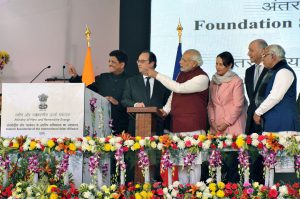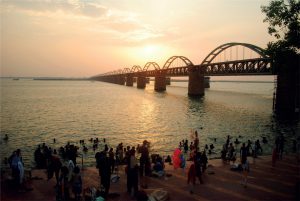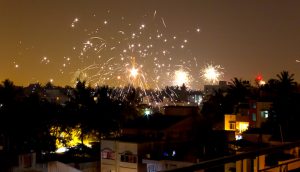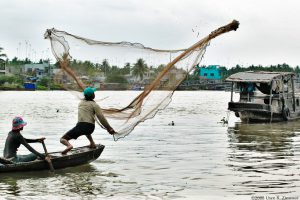From the snow-capped mountains of Tibet, the Salween rushes through steep gorges in Yunnan Province and flows through four of Myanmar’s ethnic states before emptying into the Andaman Sea.
With dams on hold upstream, Yunnan’s provincial chief Li Jiheng expressed support in 2016 for a national park to stimulate this region’s tourism in the upper Salween (the Nu River) which already attracts many visitors to the ‘Three Parallel Rivers’ World Heritage site. Although Li Jiheng was recently replaced by Chen Hao, it is hoped that the dams will remain suspended.
Paul Sein Twa, chairman of the Karen Environmental and Social Action Network (KESAN) commented, “If China does not build dams on the Salween, Burma also should not build any. They should work together. This river should flow freely starting from the river’s source to its mouth”.
The National League of Democracy (NLD) government led by Aung San Suu Kyi certainly appears to be working closely with China but not in the direction of protecting the Salween.
Aung San Suu Kyi selected China for her first overseas state visit. She also appears to be attentive to the concerns of their hydropower corporations lobbying to build dams in Myanmar. But Aung San Suu Kyi needs to listen to other Chinese voices.
She has not had the opportunity to hear other Chinese voices such as the award-winning environmentalist Yu Xiaogang, founder of the Yunnan-based NGO Green Watershed.
Speaking about the Kunlong dam in Myanmar, Yu told this correspondent, “I heard this dam will be built in the border area on the Myanmar side. I am very concerned this same area is in the earthquake zone that can produce an earthquake of 8.00 degrees [on the Richter scale].
So if the Chinese government stop dams, then I think Myanmar the downstream country must consider this earthquake risk to their people.”
Watch: Every River Has a Story: Dr. Yu Xiaogang
Hopes dashed by new democratic regime
The hopes of ethnic minorities in Myanmar, who depend on the undammed Salween River (also known as the Thanlwin) for their cultural and economic survival, have been dashed by the new government’s approval of hydropower dam projects inherited from the previous military regimes.
Aung San Suu Kyi, a pro-democracy icon during the long years of military rule, led the NLD to a landslide victory in the 2015 election, promising a new era of democratisation and respect for human rights. The election manifesto of the NLD included a commitment to a new energy policy and warned that, “The construction of the large dams required for the production of hydropower causes major environmental harm.”
But while the controversial Myitsone dam on the Irrawaddy has been suspended pending review by a special government commission, plans for a cascade of dams on the Salween are still moving ahead. Without first carrying out any kind of review of these environmental impacts, U Htein Lwin, permanent secretary at the Ministry of Electric Power, announced on 12 August 2016 that hydropower projects would go ahead on the Salween during a press conference to mark the government’s first 100 days in power.
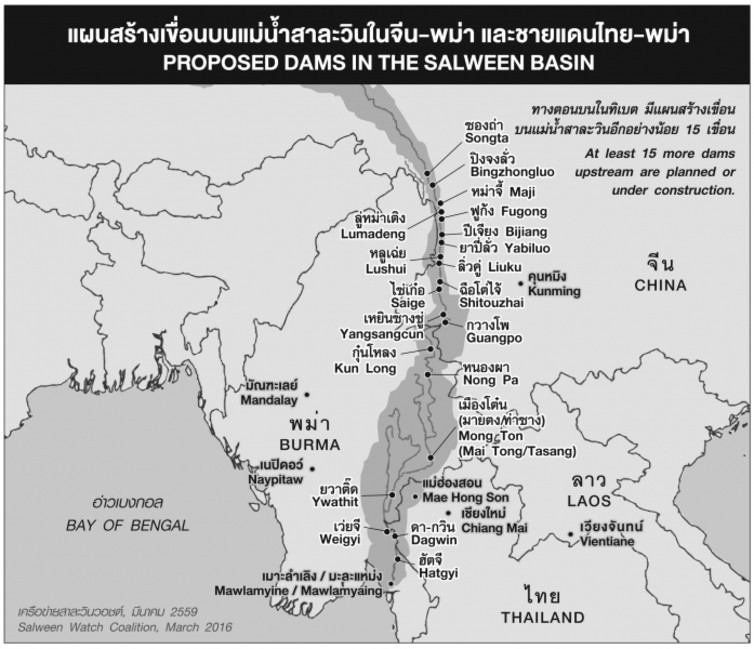
See: China faces tougher laws in Myanmar
Campaigners say the dams will displace thousands of people and threaten the fragile peace process. Nonetheless the current government’s focus is on access to energy for the general population. Only about 30% of the population connected to the national electricity grid and the NLD desperately wants to change that number.
But energy experts say Chinese and Thai backed dam projects on the Salween do not seriously address the domestic energy deficit. Two of the largest dams: the 7,100 MW Mong Ton in Shan State and the 1,360 MW Hat Gyi in Karen State will deliver 90% of electricity generated to China and Thailand according to the MOU’s signed with Chinese companies such as Sino-hydro, the Three Gorges Corporation and EGATI (Thailand’s Electricity Commission). Only 10% of electricity is assigned to the country that needs it most – Myanmar. Moreover with increasing irregularity of water flows due to climate change and melting glaciers, the energy flow from these dams will also be affected.
Civil society and ethnic groups are advocating green energy alternatives in place of mega-dams. Aung Myint, General Secretary of the Renewable Energy Association of Myanmar (REAM) reports that it would be cheaper and faster to install electricity outside Myanmar’s very weak national grid. Decentralized mini grids can be easily installed either for small hydropower or solar in remote areas. These could form part of a new energy policy harnessing solar and wind-power as the fastest options to supply rural communities starved of electricity.
Environmental destruction and earthquake risks
Shan environmentalist Sai Khur Hseng from the NGO Sapawa told thethirdpole, “We expected the new government to declare a moratorium on Salween dams. Shan people are surprised that the new government does not respect our ethnic rights.”
The free-flowing Salween is the last important undammed river in Asia. Endangered species including the tiger and the clouded leopard can still be found in remote parts of Myanmar’s Karen State where the river flows.

The government’s approval of six dams (including one on a major tributary), with all finance and construction in the hands of Chinese hydropower corporations in partnership with Egat Thailand, has deeply disappointed the anti-dam movement. They have spent years campaigning to protect the interests of an estimated 7 million people comprising ethnic Karen, Karenni, Mon and Shan, and to protect the free-flow of the river, and had expected more empathy from a government elected with a popular mandate to bring about change.
The Mongton dam, if built, will be one of the largest reservoirs in Asia with a projected reservoir area over 600 square kilometres.
Sai Khur Hseng lamented, “The decision has been carried out in secret. It was done with no consultation, no dialogue and no review. Nothing has changed. They are just carrying out the same policy as the previous military regime.”
That a government elected on a mandate of its pro-democracy credentials has approved dams with potentially devastating impacts on the civilian population of the lower Salween, offers an ironical contrast with the suspension of dams upstream in China where the upper Salween is known as the Nu River. In 2004 the then Chinese premier Wen Jiabao ordered the suspension of all 13 dam projects, after sustained protests highlighted citing the lack of environmental safeguards and risks from construction in an active earthquake zone.
This grand exception to the frenzy of Chinese dam building was the result of a spirited anti-dam campaign by journalists, environmentalists and people living along the Nu River (the upper Salween) assisted by Green Watershed NGO and the scientific research of two well-respected Chinese geologists.
In 2016 the dams on the Chinese side of the border are still on hold, but this has not deterred Chinese hydropower companies from aggressively lobbying the NLD government to implement dam-building projects across the Myanmar border.
Hla Hla Aung, a senior researcher at the Myanmar Earthquake Committee, said, “If they build dams along the Salween River, it means they are going to build dams in the most earthquake-prone region in Myanmar.”
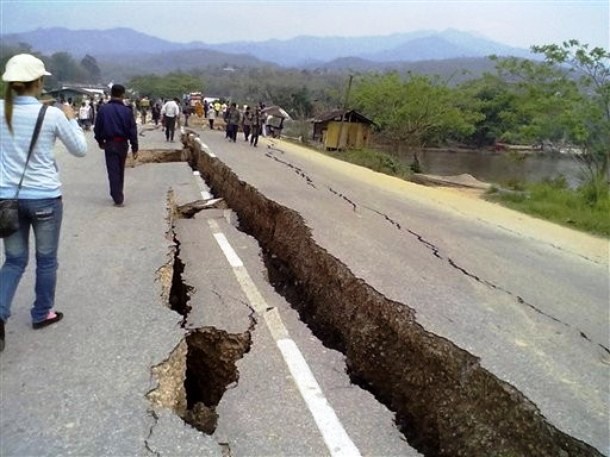
Military power being used to clear out space for dams
Local groups argue the momentum to push ahead with these dams is the main reason for the recent military clashes inside ethnic Karen State in September 2016, and the displacement of another 5,000 villagers who fled in terror from an area close to the Hat Gyi dam site.
Naw Hsa Moo, a spokesperson for Karen Rivers Watch, explained that, “If you look at the map, you can see that the army offensives are near the Hatgyi dam. They are trying to use force to clear the area so the dam can begin.”
Karen Rivers Watch reported, “Not only is there the humanitarian crisis caused by the [clearing the area] dam construction, if the dam is built, large areas will be flooded and large numbers of people displaced forever.”
In the ethnic Shan State the same pattern of offensives by government troops and displacement of civilian population has occurred close to dam-sites located inside the conflict zones, where ethnic rebel forces control significant amounts of territory,
Suu Kyi, State Counsellor and Foreign Minister of the new government, has at the national level been trying to pursue peace talks by rekindling the spirit of her father’s famous founding Panglong Conference that proclaimed the equality of all ethnic groups within the union in 1947.
However the Myanmar military that seized power in the 1962 coup still retains full control over internal security and military affairs.
The Karen National Union (KNU), which has been waging a struggle for autonomy and partial control over their natural resources for decades, signed a ceasefire agreement with the previous government in 2012.
But these fragile ceasefires have been frequently violated. The KNU vice-president Zipporah Sein told our documentary team, “It is KNU policy that mega projects like Hat Gyi hydropower dam will not be permitted until there is a political settlement. If they use force to build dams in our territory, it will create conflict. It will surely disrupt the current peace building process. “
Zipporah Sein appears in our film: Mega-dams on the Salween
Under the control of the KNU is their armed wing the Karen National Liberation Army (KNLA) already committed to blocking dam construction until a peace agreement and political settlement has been signed.
Tom Fawthrop directed and produced Mega-dams on the Thanlwin/Salween for DVB TV station- The Democratic Voice of Burma.
Eureka Films productions also includes two documentaries on the Mekong dams that he has directed.
His series on the Damming of the Mekong has been published by The Economist UK and other reports appeared in the Guardian and the South China Morning Post
